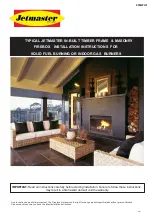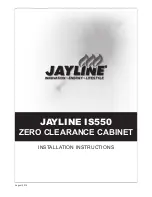
11
Warning Note
Properly installed, operated and maintained this stove will not emit fumes into the dwelling. Occasional fumes from
de-ashing and re-fuelling may occur. However, persistent fume emission is potentially dangerous and must not be tolerated.
If fume emission does persist, then the following immediate action should be taken:-
(a) Open doors and windows to ventilate the room and then leave the premises.
(b) Let the fire go out.
(c) Check for flue or chimney blockage and clean if required
(d) Do not attempt to relight the fire until the cause of the fume emission has been identified and corrected. If necessary
seek expert advice.
The most common cause of fume emission is flueway or chimney blockage. For your own safety these must be kept clean
at all times.
CO Alarm
Your installer should have fitted a CO alarm in the same room as the appliance. If the alarm sounds unexpectedly, follow the
instructions given under “Warning Note” above.
Chimney Fires
If the chimney is thoroughly and regularly swept, chimney fires should not occur. However, if a chimney fire does occur turn
the air control setting to the minimum, and tightly close the doors of the stove. This should cause the chimney fire to go
out in which case the control should be kept at the minimum setting until the fire in the stove has gone out. The chimney
and flue ways should then be cleaned. If the chimney fire does not go out when the above action is taken then the fire
brigade should be called immediately.
After a chimney fire the chimney should be carefully examined for any damage. Expert advice should be sought if necessary
HETAS Ltd Approval
These appliances have been approved by HETAS Ltd as an intermittent operating appliance for burning both wood and smokeless
fuels only.
HETAS recommended fuels
:
Please note that HETAS Ltd Appliance Approval only covers the use of wood logs and approved smokeless fuels on this appliance.
HETAS Ltd Approval does not cover the use of other fuels either alone or mixed with the recommended fuels listed above, nor
does it cover instructions for the use of other fuels.
1. Fire Will Not Burn - check
a) the air inlet is not obstructed in any way,
b) that chimney and flue ways are clear,
c) that a suitable fuel is being used,
d) that there is an adequate air supply into the room,
e) that an extractor fan is not fitted in the same room as
the fire.
2. Fire Blazing Out Of Control - check
a) the doors are tightly closed,
b) the air controls are turned down to the minimum
setting,
c) the flue damper is closed ( if fitted),
d) a suitable fuel is being used,
e) the door seals are in good condition.
f) the chimney draft may be too strong
g) check ash pan seal and
h) check for ash below ash pan causing pan to seat
incorrectly and clean out.
3) Soot forms on the window
a) The firewood may be too wet
b) the intake of secondary air may be insufficient
c) fire not hot enough
3) Soot forms on the window
a) The firewood may be too wet
b) the intake of secondary air may be insufficient
c) fire not hot enough
4) The stove fails to heat fully
a) The firewood may be too wet
b) the intake of secondary air may be insufficient
5) Smoke or odour
a) Weak chimney draft
b) check for blockages in the flue pipe/chimney
c) check the height of the chimney relative to the
surroundings
6) Soot in the chimney
a) The firewood may be too wet
b) intake of secondary air may be insufficient
Trouble shooting






























